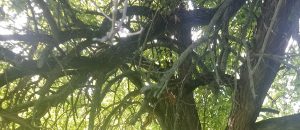November 13th
63 Degrees
2:15 PM

Nearly all of the leaves have fallen, and the spot seems completely different than it did in September – it makes for a fitting final blog. Today, it was sunny with a few puffy white clouds – with the cool wind, it was very pleasant. During my first few minutes I chose to focus on the areas I don’t usually see from my spot. I took a walk around the tree and looked closer at the northwest side. During my previous visit I remarked that I believed another plant grew in the treetop, and on this side of the tree I noticed thick woody vines climbing far up the tree. I also saw four clusters of long, slender, thorny branches; two sprouted from the ground and two from the actual tree. Although the branches are completely different from the main tree, the leaves seem similar – however, it is possible that it is a separate symbiotic species. In addition to the vines, there was moss on roots and ivy climbing the very base of the tree. I was also able to see more animals than usual with the clearing foliage; a grey cat, huge black ants, and a few small green bugs were some of the species I hadn’t seen in this space before.
After my first fifteen minutes, I focused on the species I’ve identified. There were four new purple knapweed flowers in a cluster beneath the tree. The ground ivy has also changed – it seems like the leaves are smaller, and the plants shorter. I think since these plants prefer shade, the exposure to direct sunlight due to the disappearance of the leaves of the tree may have caused it. It is also possible that the opposite problem, too much shade due to the leaf litter on the ground, is the culprit. It was easier to observe some new plant’s characteristics due to other species losing leaves that used to block them. The ivy on the other side of the tree is a type of English Ivy. Though some characteristics are more noticeable, the changes that many plants undergo in the fall, namely the loss of leaves, makes identification difficult.

For the most part, my objects are similar to how they were in September, though they’ve gone through phases in the interim, such as the loss and regaining of leaves. The major changes in the branch since my first visit has been the shedding of both dead and living leaves, as well as the increase in spiderwebs. The plant has also shed leaves, but still has those new shoots from the last visit. The stick has perhaps changed the most, as it is half of its original size and has been completely covered in leaves and plants. It has also undergone changes in color, most recently developing splotches of rusty orange and black.
Considering ecological concepts in relation to the spot was interesting and felt like the best exercise to wrap up my time here. Some relationships were easy to pick out, and the concepts that seem most prevalent in this space are competition and symbiosis. The ground ivy seems to be the dominant competitor, and as I discovered before, it even employs allelopathy to crowd out other species like our textbook example. Many of the plants in this community seem interdependent, and especially reliant on the tree. The vines that grow up the trunk are probably the best example – it’s likely they utilize the height of the tree to gain a photosynthetic advantage. The ivies also utilize the shade of the tree, just as insects utilize the protection of the ivy. The tree doesn’t seem very healthy, which makes me wonder if one of these relationships may be parasitic.
Even though we’ve only spent a short time with our spots, I feel I’ve learned a lot – the change from summer to fall feels like a good snapshot of the lifecycle of these small communities. Being able to apply the concepts we learn in the classroom to real communities definitely enhances the learning process, and I feel more aware of relationships in nature even when I’m not intentionally looking. I hope to keep utilizing these observation skills in the future, and I’m excited to perhaps visit my spot in the spring to observe those changes.
(Photos are from previous visits)

I liked how you thought of symbiosis. I never thought about that while sitting at sit spot and thinking about the concepts we covered in the class.
Nice blog Kady….I have enjoyed watching you observe and connect to this space! did you ever figure out the species of tree?
Unfortunately, I didn’t! Maybe I can go back out with a field guide when the leaves grow back in the Spring.
I like the way you talked about ground ivy and symbiosis, that’s really cool! I have some Ivy in my sit spot too, and now I’m wondering if it’s parasitic as well.